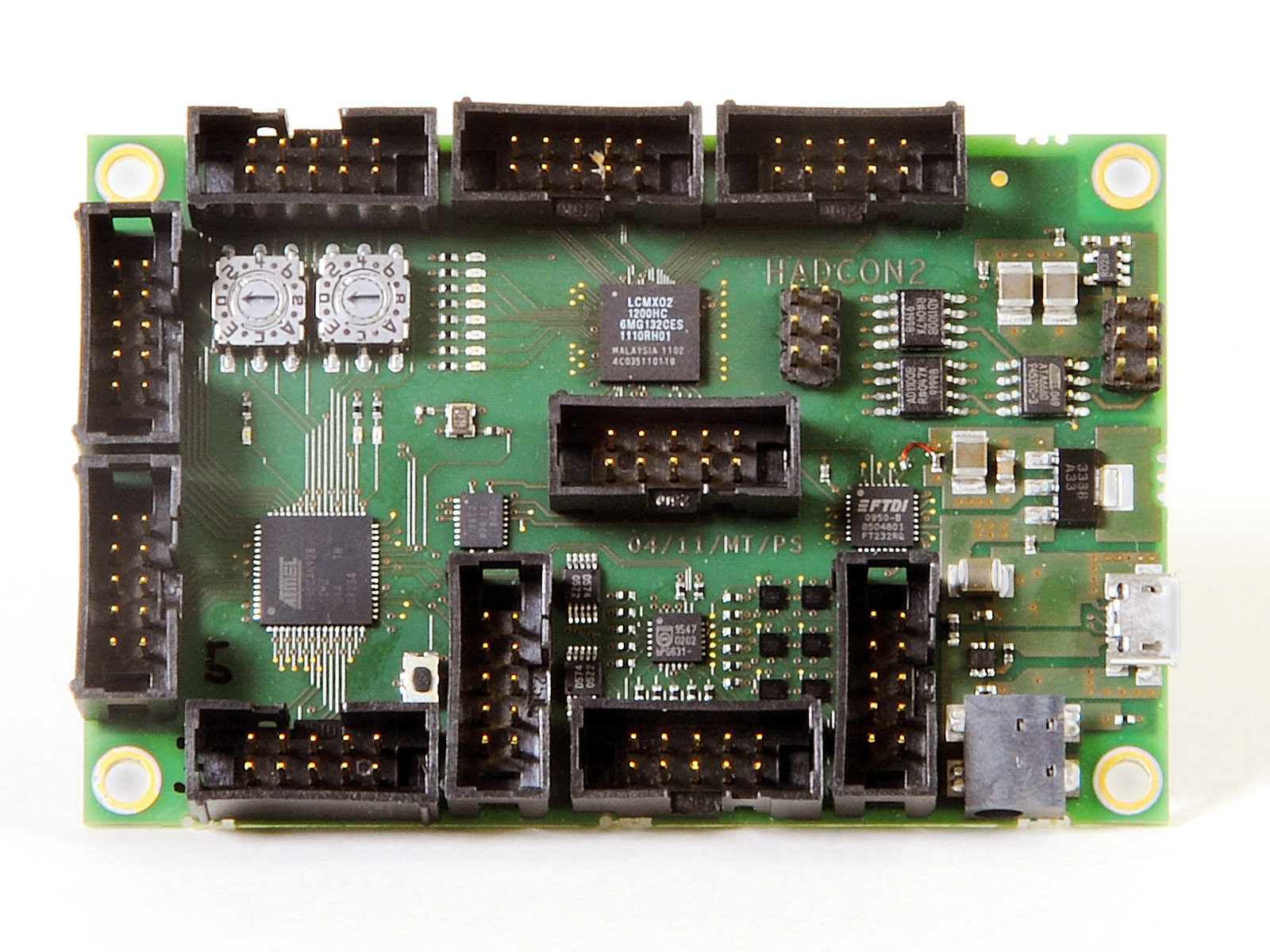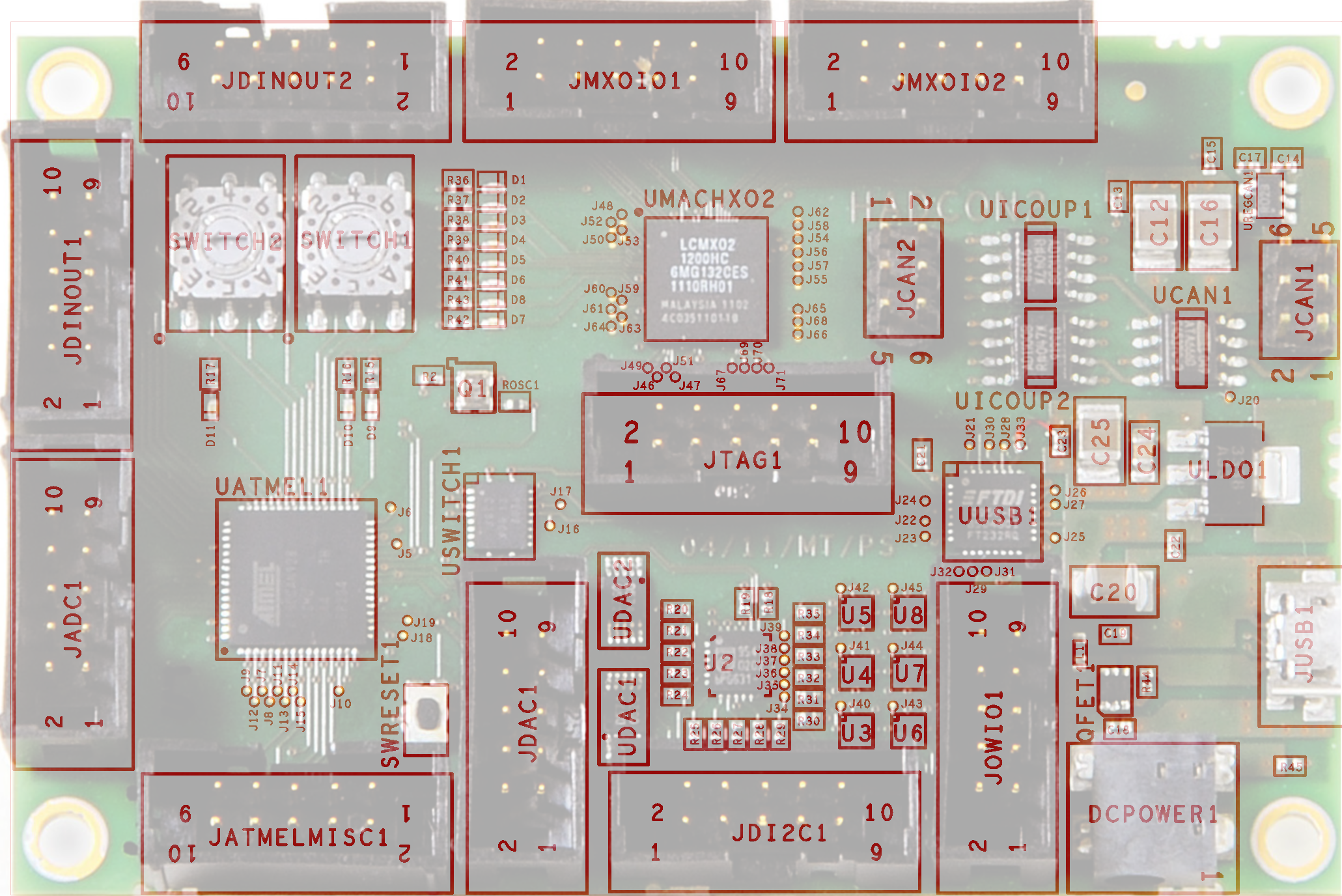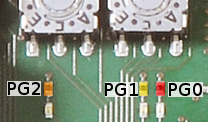You are here: GSI Wiki>Epics Web>EpicsProjectsAndActivities>HardwarePlatforms>HadCon2 (2020-07-31, PeterZumbruch)Edit Attach

HadCon 2
Introduction
HadCon2 is a credit-card sized general purpose I/O module for detector and experiment controls as well as for small data acquisition systems.
 It is the successor of the discontinued first version HadCon ( HADControl/HadShoPoMo general purpose board, HadCon @ Epics Wiki).
The module has an ATMEL AT90CAN128 microcontroller providing a multitude of connectivity:
It is the successor of the discontinued first version HadCon ( HADControl/HadShoPoMo general purpose board, HadCon @ Epics Wiki).
The module has an ATMEL AT90CAN128 microcontroller providing a multitude of connectivity:
It doesn't have any CPU on board, but a USB connector to directly allow communication with any type and size of computer (e.g. PC, raspberry PI, dreamplug, ...) having an USB port on one side and at the other end the microcontroller and the FGPA. This communication is based on an ASCII-based protocol in view of easy implementation in detector control systems like e.g. EPICS and LabVIEW.
 It is the successor of the discontinued first version HadCon ( HADControl/HadShoPoMo general purpose board, HadCon @ Epics Wiki).
The module has an ATMEL AT90CAN128 microcontroller providing a multitude of connectivity:
It is the successor of the discontinued first version HadCon ( HADControl/HadShoPoMo general purpose board, HadCon @ Epics Wiki).
The module has an ATMEL AT90CAN128 microcontroller providing a multitude of connectivity:
I2C (8/4 fold (intern/extern) multiplexer), 6 channel 1-wire master, 8-channel 8bit DAC, galvanically isolated CAN - high-speed transceiver, 8-channel 10-bit SAR ADC, byte-oriented SPI, in total up-to 53 programmable I/O lines and optionally a Lattice MachX02 FPGA for fast data processing tasks.
While the discontinued precursor HadCon had an SoC on-board, its successor HadCon2 has broken up this concept in favour of a more open access:It doesn't have any CPU on board, but a USB connector to directly allow communication with any type and size of computer (e.g. PC, raspberry PI, dreamplug, ...) having an USB port on one side and at the other end the microcontroller and the FGPA. This communication is based on an ASCII-based protocol in view of easy implementation in detector control systems like e.g. EPICS and LabVIEW.
- Summarizing:
- Microcontroller: ATMEL AT90CAN128
- I2C
- CANbus
- SPI
- ADCs
- ...
- FPGA: Lattice MachX02-1200-HC
- FTDI USB to serial UART interface
- USB 2.0 connector
- Power over USB
- I2C devices
- 6 × Single-Channel 1-Wire Master
- 1 × 8-channel I2C-bus multiplexer with reset
- 2 × 4-channel 8-Bit DAC - Digital-to-Analog Converter
- galvanically isolated CAN - High-speed CAN Transceiver
- optional external power supply
- 2 × Rotary Code Switches, hexadecimal coding
- Reset Button for ATMEL
- 11 × LED's, free programmable
- Microcontroller: ATMEL AT90CAN128
Documentation
Layout
- Schematic (local copy)
- top view assembly of HadCon2

click to enlarge :
:
- Proportions/Dimensions of HadCon2
Microcontroller ATMEL
FPGA
- MachX02-1200-HC
FTDI USB to serial UART interface
USART - Universal Synchronous and Asynchronous serial Receiver and Transmitter
| connects to | |
|---|---|
| USART0 | FTDI (USB) |
| USART1 | FPGA |
I2C
1 × 8-channel I2C-bus multiplexer with reset
-
 PCA9547, local copy
PCA9547, local copy - ATMEL's SDA/SCLsignals are multiplexed to up-to 8 lines.
Multiplexer out Device Signals ATMEL's SDA/SCLSD0/SC0DAC1: 4-channel DAC (DAC5574) DACOUT1 ... DACOUT3DAC2: 4-channel DAC (DAC5574) DACOUT4 ... DACOUT7SD1/SC1, SDA1 / SCL1Connector JDI2C1 SD2/SC2, SDA2 / SCL2SD3/SC3, SDA3 / SCL3SD4/SC4, SDA4 / SCL4SD5/SC52 × Single-Channel 1-Wire Master OWIO0 ... OWIO1SD6/SC62 × Single-Channel 1-Wire Master OWIO2 ... OWIO3SD7/SC72 × Single-Channel 1-Wire Master OWIO4 ... OWIO5 - Addressing:
Device I2C sub address Signals A2 A1 A0 U2: 8-channel I2C-bus multiplexer 0 0 0 OWIO0
- ATMEL's SDA/SCLsignals are multiplexed to up-to 8 lines.
- The configuration can be set via I2C.
- Device Addressing: (from manual)
0b1110sssd, s:hardware selectable, d:direction R/\\bar(W) - Channel Select via Control Register:
- Table 4. Control register
Write = channel selection; Read = channel status D7 D6 D5 D4 B3 B2 B1 B0 Command X X X X 0 X X X no channel selected 0 0 0 0 1 0 0 0 channel 0 enabled; power-up/reset default state X X X X 1 0 0 0 channel 0 enabled X X X X 1 0 0 1 channel 1 enabled X X X X 1 0 1 0 channel 2 enabled X X X X 1 0 1 1 channel 3 enabled X X X X 1 1 0 0 channel 4 enabled X X X X 1 1 0 1 channel 5 enabled X X X X 1 1 1 0 channel 6 enabled X X X X 1 1 1 1 channel 7 enabled
- Device Addressing: (from manual)
- Connected to ATMEL's pin
PB5 (OC1A)[...] pulling the RESET pin LOW resets the I2C -bus state machine causing all the channels to be deselected, except Channel 0 so that the master can regain control of the bus (from the manual].
6 × Single-Channel 1-Wire Master
-
 I2C-to-1-Wire® bridge device DS2482-101, local copy
I2C-to-1-Wire® bridge device DS2482-101, local copy
- Features:
- slew-rate control
- "To optimize 1-Wire waveform generation, the DS2482-101 performs slew-rate control on rising and falling 1-Wire edges and provides additional programmable features to match drive characteristics to the 1-Wire slave environment."
- pullup features
- "Programmable, strong pullup features support 1-Wire power delivery to 1-Wire devices such as EEPROMs and sensors."
- Addressing:
| Device | I2C sub address | Signals | |
|---|---|---|---|
| A1 | A0 | ||
| U3: Single-Channel 1-Wire Master | 1 | 0 | OWIO0 |
| U6: Single-Channel 1-Wire Master | 1 | 1 | OWIO1 |
| U4: Single-Channel 1-Wire Master | 1 | 0 | OWIO2 |
| U7: Single-Channel 1-Wire Master | 1 | 1 | OWIO3 |
| U5: Single-Channel 1-Wire Master | 1 | 0 | OWIO4 |
| U8: Single-Channel 1-Wire Master | 1 | 1 | OWIO5 |
2 × 4-channel 8-Bit DAC - Digital-to-Analog Converter
-
 Quad, 8-Bit, Low-Power, Voltage Output, I2C Interface Digital To Analog Converter, DAC5574, local copy
Quad, 8-Bit, Low-Power, Voltage Output, I2C Interface Digital To Analog Converter, DAC5574, local copy
- Addressing:
| Device | I2C sub address | Signals | |
|---|---|---|---|
| A1 | A0 | ||
| UDAC1: 4-channel DAC (DAC5574) | 1 | 0 | DACOUT1 ... DACOUT3 |
| UDAC2: 4-channel DAC (DAC5574) | 0 | 0 | DACOUT4 ... DACOUT7 |
galvanically isolated CAN-bus
Can - High-speed Can Transceiver
iCoupler Digital Isolator
decoupling ATMEL's JTAG from ADC input
8-bit noninverting translator
-
 TXB0108RGYR - 8-BIT BIDIRECTIONAL VOLTAGE-LEVEL TRANSLATOR, local copy
TXB0108RGYR - 8-BIT BIDIRECTIONAL VOLTAGE-LEVEL TRANSLATOR, local copy
-
OEpin is connected to ATMEL'sTOSC2, by pulling it down, it decouples overlapping JTAG input from ADC inputsADC4-7
Switches
Rotary Code Switches, hexadecimal coding
- 2 ×
 Rotary Code Switches, hexadecimal coding - P36SMT , local copy
Rotary Code Switches, hexadecimal coding - P36SMT , local copy
- pull ATMEL's
PC0...PC8down toGND
| SWITCH1 | Connector Pins | AT90CAN128 via 4.7kΩ | SWITCH2 | Connector Pins | AT90CAN128 via 4.7kΩ | |
|---|---|---|---|---|---|---|
| 1 | PC0 (A8) |
1 | PC4 (A12) |
|||
| 2 | PC1 (A9) |
2 | PC5 (A13) |
|||
| 4 | PC2 (A10) |
4 | PC6 (A14) |
|||
| 8 | PC3 (A11) |
8 | PC7 (A15/CLK0) |
Reset Button
- KMR223 ITT micro miniature switch
- pulls up ATMEL's
RESET(pin20) to 3.3V via 10kΩ
Power
Input
Powering via- micro USB
JUSB1connector, or
- jack
DCPower
Output
| GND | Can be found on several Connectors | |
|---|---|---|
| 5,0V | JCAN2 |
pin 4 |
| 3,3V | JCAN2 |
pin 6 |
LEDs

| pin | color | logic | |
|---|---|---|---|
| AT90CAN128 | PG0 ( WR ) |
♦ red | inverse logic: 0: on 1: off |
| AT90CAN128 | PG1 ( RD ) |
♦ yellow | inverse logic: 0: on 1: off |
| AT90CAN128 | PG2 (ALE) |
♦ orange | inverse logic: 0: on 1: off |
| MachX02 | PT17D "DONE" |
♦ red | |
| MachX02 | PL4A |
♦ yellow | |
| MachX02 | PL4B |
♦ orange | |
| MachX02 | PL4C |
♦ yellow | |
| MachX02 | PL4D |
♦ orange | |
| MachX02 | PL5A |
♦ red | |
| MachX02 | PL5B |
♦ yellow | |
| MachX02 | PL5C |
♦ orange |
Connectors
JDINOUT1 / JDINOUT2
- I/O of ATMEL
| JDINOUT1 | Connector Pins | AT90CAN128 | JDINOUT2 | Connector Pins | AT90CAN128 | |
|---|---|---|---|---|---|---|
| 1 | PA0 (AD0) |
1 | PC0 (A8) |
|||
| 2 | PA1 (AD1) |
2 | PC1 (A9) |
|||
| 3 | PA2 (AD2) |
3 | PC2 (A10) |
|||
| 4 | PA3 (AD3) |
4 | PC3 (A11) |
|||
| 5 | PA4 (AD4) |
5 | PC4 (A12) |
|||
| 6 | PA5 (AD5) |
6 | PC5 (A13) |
|||
| 7 | PA6 (AD6) |
7 | PC6 (A14) |
|||
| 8 | PA7 (AD7) |
8 | PC7 (A15/CLK0) |
|||
| 9/10 | GND | 9/10 | GND |
JADC1
- ADC inputs of ATMEL
| Connector Pins | AT90CAN128 | comments |
|---|---|---|
| 1 | PF0 (ADC0) |
|
| 2 | PF1 (ADC1) |
|
| 3 | PF2 (ADC2) |
|
| 4 | PF3 (ADC3) |
|
| |
||
| 5 | PF4 (ADC4) |
overlap with JTAG inputs of ATMEL, can be decoupled by pulling TOSC2 low |
| 6 | PF5 (ADC5) |
|
| 7 | PF6 (ADC6) |
|
| 8 | PF7 (ADC7) |
|
| |
||
| 9/10 | GND | |
JAtmelMISC1
- ATMEL miscellaneous I/O, SPI
| Connector Pins | AT90CAN128 | comments |
|---|---|---|
| 1 | PD2 (RXD1/INT2) |
USART1 RXD to connection to MachX02 or External Interrupt 2 Input |
| 2 | PD1 (TXD1/INT3) |
USART1 TXD to connection to MachX02 or External Interrupt 3 Input |
| 3 | PB0 ( SS ) |
Serial Peripheral Interface – SPI |
| 4 | PB1 (SCK) |
|
| 5 | PB2 (MOSI) |
|
| 6 | PB3 (MISO) |
|
| 7 | PE6 (T3/INT6) |
Timer/Counter3 Clock Input or External Interrupt 6 Input |
| 8 | PE7 (ICP3/INT7) |
Timer/Counter3 Input Capture Trigger or External Interrupt 7 Input |
| |
||
| 9/10 | GND | |
JTAG1
- JTAG connector
| Connector Pins | Signal | comments |
|---|---|---|
| 1 | TCK |
10kΩ to V3_3 |
| 2 | GND |
|
| 3 | TDO |
← FPGA / Jumper J1 ← ATMEL |
| 4 | V3_3 |
|
| 5 | TMS |
|
| 6 | not connected | |
| 7 | V3_3 |
|
| 8 | not connected | |
| 9 | TDI |
→ ATMEL (→ FPGA) |
| 10 | GND |
JCAN1 / JCAN2
- JCAN1 basic CAN connector
| JCAN1 | Connector Pins | Signal | comments |
|---|---|---|---|
| 1 | CANL |
↔ CAN - High-speed Can Transceiver ATA6660 ↔ iCoupler Digital Isolator ↔ ATMEL | |
| 2 | CANH |
||
| 3/5 | VCAN_INPUT |
||
| 4/6 | GND_CAN |
-
JCAN2provides optional CAN power supply,
needs a jumper/cable/connection- between pin
1, GND_CANand pins3/5for commonGND - between pin
2, VCANand pins4for5,0Vor - between pin
2, VCANand pins6for3,3V
- between pin
| JCAN2 | Connector Pins | Signal |
|---|---|---|
| 1 | GND_CAN |
|
| 2 | VCAN |
|
| 4 | V5_0 |
|
| 6 | V3_3 |
|
| 3/5 | GND_CAN |
JMXOIO1 / JMXOIO2
- LVDS I/O of FPGA MachX02
| JMXOIO1 | Connector Pins | MachX02 | JMXOIO2 | Connector Pins | MachX02 | |
|---|---|---|---|---|---|---|
| 1/2 | PT9A/B |
1/2 | PT15A/B |
|||
| 3/4 | PT10A/B |
3/4 | PT16A/B |
|||
| 5/6 | PT11A/B |
5/6 | PT16C/D |
|||
| 7/8 | PT12A/B |
7/8 | PT17A/B |
|||
| 9/10 | GND |
9/10 | GND |
JDI2C1
- 4 of 8 channel output of ATMEL's single I2C bus multiplexed by an 8-channel I2C multiplexer PCA9547 (q.v. above)
| Connector Pins | Multiplexer out | task | comment |
|---|---|---|---|
| 1/2 | SD1/SC1 |
SDA1 / SCL1 | ATMEL's multiplexed SDA/SCL |
| 3/4 | SD2/SC2 |
SDA2 / SCL2 | |
| 5/6 | SD3/SC3 |
SDA3 / SCL3 | |
| 7/8 | SD4/SC4 |
SDA4 / SCL4 | |
| 9/10 | GND |
JDAC1
- Output of the 2 4-channel DAC (DAC5574)
| Connector Pins | Signal | Device | Device pin |
|---|---|---|---|
| 1 | DACOUT0 |
UDAC1 | VoutA |
| 2 | DACOUT1 |
VoutB |
|
| 3 | DACOUT2 |
VoutC |
|
| 4 | DACOUT3 |
VoutD |
|
| 5 | DACOUT4 |
UDAC2 | VoutA |
| 6 | DACOUT5 |
VoutB |
|
| 7 | DACOUT6 |
VoutC |
|
| 8 | DACOUT7 |
VoutD |
|
| 9/10 | GND |
JOWIO1
- 1-wire connector for 6 channels provided by the 6 I2C driven Single-Channel 1-Wire Master DS2482
| Connector Pins | Signal |
|---|---|
| 1 | OWIO0 |
| 2 | OWIO1 |
| 3 | OWIO2 |
| 4 | OWIO3 |
| 5 | OWIO4 |
| 6 | OWIO5 |
| 7/8 | V3_3 |
| 9/10 | GND |
Bugs, Notes, Remarks, Tweaks & Twiddling
Notes and Remarks
1-wire
- When driving 1-wire devices, typically via
JOWIO1, make sure to have (at least) 1 pull-up resistor of about 3.3kΩ on the data line of the 1-wire bus connected to the power VDD.- Recommended to have it at the master, e.g. at HadCon 's connector
JOWIO1,. - Possible option for future, directly at the connector, when using one of JDINOUT2'spins as permanent power pin.
- Since Single-Channel 1-Wire Master DS2482 is used at
JOWIO1, this isn't necessary anymore, but keep in mind for other applications.
- Recommended to have it at the master, e.g. at HadCon 's connector
Tweaks / Bugfix
- template 1
- description
Therefore Action: i.e.- pin 5 of
UFF2has to be disconnected from its pad and removed - A cable has to be soldered connecting pin 1 of
UFF2to the solder pad of pin 5
- pin 5 of
- template 2
- description
Therefore Action: i.e.- pin 5 of
UFF2has to be disconnected from its pad and removed - A cable has to be soldered connecting pin 1 of
UFF2to the solder pad of pin 5
- pin 5 of
Firmware
Cables
Bookkeeping / Organization
-- PeterZumbruch - 2020-07-31
Edit | Attach | Print version | History: r16 < r15 < r14 < r13 | Backlinks | View wiki text | Edit wiki text | More topic actions
Topic revision: r16 - 2020-07-31, PeterZumbruch
- User Reference
- BeginnersStartHere
- EditingShorthand
- Macros
- MacrosQuickReference
- FormattedSearch
- QuerySearch
- DocumentGraphics
- SkinBrowser
- InstalledPlugins
- Admin Maintenance
- Reference Manual
- AdminToolsCategory
- InterWikis
- ManagingWebs
- SiteTools
- DefaultPreferences
- WebPreferences
- Categories
 Copyright © by the contributing authors. All material on this collaboration platform is the property of the contributing authors.
Copyright © by the contributing authors. All material on this collaboration platform is the property of the contributing authors. Ideas, requests, problems regarding GSI Wiki? Send feedback | Legal notice | Privacy Policy (german)
